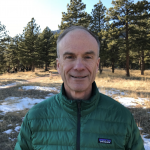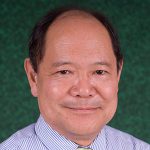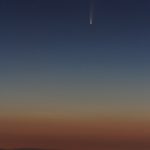
A member of the Physics department for 33 years, Professor Mark Bradley serves the department as the associate chair for research. Bradley’s research is taking on exciting new directions, so we asked him to reflect on his current research and the future challenges ahead.
Will you please provide an overview of your current research and recent discoveries?
When an energetic ion strikes a solid surface, atoms can be ejected from the solid. Bombarding a flat solid surface with a broad ion beam therefore results in erosion of the solid. Naively, one would expect that the solid surface would simply remain flat as it is eroded. Instead, a remarkable variety of self-assembled nanoscale patterns can form, including periodic height modulations or “ripples” and mounds arranged in hexagonal arrays of astonishing regularity. The spontaneous emergence of these patterns is not just fascinating in its own right, since in the future ion bombardment may prove to be an important tool in the fabrication of nanostructures.
The first type of pattern formation to be discovered was the ripples that often develop when the nominally flat surface of a solid is eroded by oblique-incidence ion bombardment. According to the theory introduced by myself and Jim Harper in 1988, this is a result of a surface instability caused by the curvature dependence of the erosion velocity: The erosion velocity is greater in a trough than at a crest.
In 1999, experiments revealed that normal-incidence ion bombardment of the binary compound gallium antimonide can lead to the formation of nanoscale mounds or “nanodots” arranged in a beautifully ordered hexagonal array. Myself and Patrick Shipman, from the CSU Mathematics department, advanced a theory that explains the genesis of these arrays in 2010. In this theory, the coupling between the topography of the surface and a surface layer of altered composition is the key to the observed pattern formation. This coupling was ignored in all prior work.
What are the biggest challenges and rewards in regards to some of your current work?
One theoretical tool that is widely used in the field is the so-called crater function formalism. This formalism takes the results of atomistic simulations of single ion impacts as input and produces estimates of the coefficients in the phenomenological equation of motion for the solid surface. In recent work, I used a generalized version of the crater function formalism to rigorously derive the equation of motion. This yielded a surprise: dispersion plays a crucial role in the pattern formation, even though its effect has been ignored for decades. Importantly, my work also places the crater function formalism on a firm mathematical footing.
What do you see emerging in the next 5 years of your research?
In the mathematical theory of pattern formation, the nonequilibrium behavior of spatially extended nonlinear systems is studied as a function of a control parameter p. Typically, the system is linearly unstable and a pattern emerges for p greater than a critical value of p which is denoted by pc, whereas the system is stable and no pattern forms for p < pc. Remarkable theoretical progress has been close to the threshold for the pattern formation, i.e., for p – pc that is small and positive.
In the case of ion bombardment of a solid, the angle of incidence θ is a control parameter that can be directly controlled in an experiment. In addition, there is a critical value of this angle, θc . For θ > θc, the surface is unstable and a pattern emerges, while for θc > θ, the surface remains flat. The mathematical theory of pattern formation therefore strongly suggests that it would be fruitful to explore the near-threshold behavior of an ion-sputtered surface. A major thrust of my groups work in the next few years will be to explore the near threshold behavior of an ion-bombarded surface.
At the present time, many aspects of the self-organization induced by ion bombardment are not fully understood. Our group is continuing to work closely with experimentalists to provide answers to many of the open questions in the field. We are using continuum modeling, the mathematical theory of pattern formation, and computer simulations in our research.


